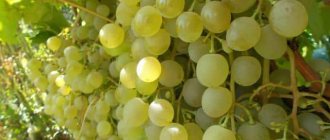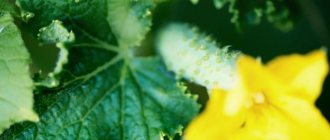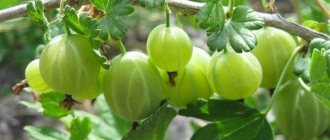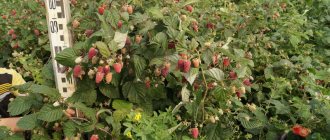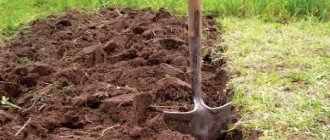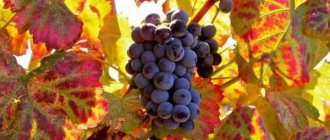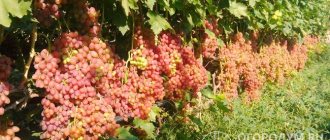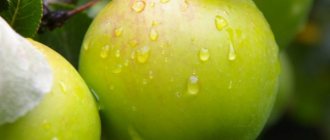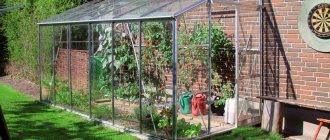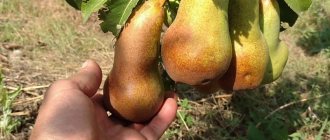Gardeners grow most grape varieties in the southern regions, because they are a heat-loving crop. But winegrowers living in the middle zone also have the opportunity to enjoy delicious berries. For them, amateur breeder N.V. Krainov developed the “Nizina” grape variety. The basis was two well-known species “Talisman” (second name “Kesha 1”) and “Radiant Kishmish”, therefore “Nizina” is considered a hybrid grape variety. To make your acquaintance with the “Nizina” grapes complete, the article will pay attention to the description of the variety, photos and reviews about it, and will also offer a useful video for your reference:
Description of the grapes Nizina
Being a descendant of the Kesha variety, Nizina practically repeats its exterior with the exception of a few small differences.
Shoots older than the second year are brownish in color, younger shoots are green. The length of the vine of the Nizina grape ranges from 15 to 18 m, which is slightly less than that of its ancestor, but still significantly longer than that of many other grape varieties.
The size of the leaves is 12-15 cm. The leaves are predominantly five-lobed; the merging of the lateral edges of the leaves into three-lobed ones is rare. The petioles of the leaves are 6-7 cm long.
The arrangement of leaves is alternate, characteristic of many grape varieties. Whiskers up to 20 cm long, up to 3 mm thick.
The plant has bisexual flowers of small size and a regular light green color. Inflorescence of panicle type. The beginning of flowering is in the 2-3 decades of May.
The most important difference between the Nizina variety and others is its brush. It is one of the largest among temperate climate zone grapes. The weight of the brush can reach up to 3 kg (the average one will pull about 1.5 kg).
The size of the berries is also impressive: their diameter can reach up to 35 mm, with the average diameter of the berries in the cluster being about 20 mm. The color of the berries can be very diverse - from reddish to bright purple.
A special feature of the variety is the early coloring of the berries - it occurs 2 weeks before their technical ripeness.
Photos of Nizina grape fruits are shown below:
The berries have a harmonious, rich taste, while the presence of juicy and fleshy pulp is a pleasant “bonus”. The sugar content is relatively low, about 18%. Acidity levels, however, are also low - about 9 g/l. When they reach full ripeness, the berries do not crack or fall off the brush.
History of selection
By crossing two varieties Talisman and “Kesha the First” , which also has another name Radiant Kishmish , such a beautiful grape variety with excellent qualities was obtained.
The very first grape fruits saw the light in Novocherkassk. Now “Nizina” is widely popular among summer residents throughout the country.
INTERESTING : the creation of this crop does not belong to a professional breeder, but simply to a grape lover - V.I. Krainov.
His hand also includes such varieties as Blagovest, Victor, Angelika and Anyuta.
Characteristics of the variety
The variety has excellent characteristics that allow it to be grown almost throughout the entire temperate continental climate, with the exception of regions with a warm season of less than 4.5 months. Otherwise, it is a fairly unpretentious and fairly hardy crop with good disease resistance.
Drought resistance, frost resistance
The drought resistance of the crop is average - interruptions in watering for more than 30-40 days are not allowed. This is a common indicator for most grape varieties.
The frost resistance of the Nizina variety is -23 °C without shelter, which exceeds this indicator for its main “ancestor”. If the grapes are covered, they can withstand frosts down to -35 °C.
Productivity and fruiting
Fruiting of the Nizina grape variety lasts for 2-2.5 weeks. The variety is considered mid-season and its ripening time is 125-130 days. In fact, the ripening time depends on the number of sunny days and the intensity of care.
Approximate harvest time is:
- in mid-August - in warm regions;
- from August 20 to September 1 – in the regions of the middle zone;
- until September 10 – in regions with cold climates.
There are up to 22-24 shoots per bush, which, with an average fruiting rate of 70% (in Nizina this figure is from 60% to 80%), gives about 16 shoots with 1.5 clusters on each. Even in the worst case, the yield from one bush will be about 12-18 kg. With moderate planting density of grapes, the yield per 1 sq. m will be about 5-6 kg.
This indicator can be increased if the plants are planted more densely or the height of the trellises is increased, the grapes are treated more intensively with fertilizers, etc. It should be noted that the weather for this variety is not the main factor affecting the yield. When developing the variety, this principle was used as the basis for selection.
Area of application of fruits
The main purpose of this variety is typical for all table varieties - fresh consumption. However, under storage conditions at low temperatures (+ 8-10 ° C), the variety is able to retain its properties for 1-2 weeks. At temperatures from 0 °C to + 7 °C, the storage time increases significantly - up to 2 months, however, you should regularly sort through the berries and discard rotten ones.
The hard skin of the berries allows them to be transported over long distances using isothermal vans.
The variety is not used to produce raisins, since they are of mediocre quality.
It is also not used for making wine, since the low sugar content will not create a drink with a good, “grape” taste. Of course, you can add sugar, but it will already be ordinary fortified wine, which can be obtained, in fact, from any raw material.
Resistance to diseases and pests
The variety's disease resistance is relatively good. Lowland grapes resist mildew and gray rot well. However, there have been cases of it being affected by oidium.
Advantages and disadvantages of the variety
Summarizing the descriptions of the Nizina grape variety, we can indicate its positive and negative properties.
Advantages:
- high productivity;
- excellent taste and appearance of the fruit;
- good preservation and transportability of fruits;
- high fruitfulness of shoots;
- good indicators of disease resistance;
- high frost resistance.
Flaws:
- table variety not used in winemaking;
- due to the large number of shoots, the bush requires large areas;
- A large bush requires increased feeding.
Large bush sizes are not always convenient, since it is difficult to calculate acceptable feeding rates for them. Therefore, when growing the Nizina grape variety, the already considerable number of shoots is actively reduced by pruning.
Reviews from gardeners
Semyon, 43 years old, Kislovodsk
Our Nizina is three years old, growing near the southern wall. This year is the second fruiting. I made a load of 30 shoots, leaving one inflorescence on each, although two appeared on all shoots. We harvest at the end of August. The clusters and fruits are large, the berries on the south side were colored worse than those that “did not see” the light. Closer to autumn, I pinched the growth above the berry zone and the situation improved. The fruits are pink-violet, the skin cannot be felt when eating, the flesh is crisp, sweet, with a gentle sourness. With normal care, regular watering, soil fertilization and fungicidal treatments, it does not get sick. With the onset of full ripeness, we eat these berries last, since after them the taste of any variety from our vineyard is “not comme il faut.” Of course, the opinion is subjective, but still.
Leonid, 66 years old, Krasny Sulin
Three of NiZina’s own rooted seedlings were given a “non-resort” place - the acacias on the neighbor’s plot block the sun until noon, depriving the vine of a valuable dose of morning insolation, and after 15 o’clock it will be shaded by its own nut. As a result, the bushes do not gain wood well, and the brushes fail for the second year in a row. In three full seasons they bore fruit twice. The taste, color, and ripening time are captivating and motivate to extend the grape season. No cracking of the berries was observed, but the ubiquitous wasps do not allow one to relax.
Lydia, 47 years old, Volsk
Five-year-old Nizina made me happy and even very happy, although she made me worry. In the spring, just before flowering, the ovary began to fall off. It was during this period that heavy rains began, and everything changed dramatically for the better. Falling stopped abruptly, pollination went just fine. 30 full-fledged bunches were formed, of which 22 tassels were brought to full condition. High humidity during flowering clearly contributes to good self-pollination of this variety. Compared to the previous season, the grapes have become larger, each about 15 g. The simply magnificent colorful appearance of the bunches also complements the excellent taste. The plant is unpretentious in care, with 4 standard treatments from oidium it does not get sick and does not “crack”, unlike Veles.
Rules for planting grapes
Typically, for the Nizina grape variety, planting with a rootstock is not used. Planting with seedlings prevails. Although, given the growth rate of the variety, this does not play a special role.
Recommended timing
The optimal time for planting is spring, so that the plant has time during the warm season to adapt to a new location. Planting is also allowed at the end of the season, but it must be done before mid-September.
Important! When planting in the fall, the seedling should be covered for wintering.
Planting is usually done in spring or summer, at any time, as long as the air temperature is at least + 15 °C.
Choosing a suitable location
Like all grape varieties, Lowland loves the sun. Planting it in the shade is actually dooming the plant to the impossibility of completing ripening even in a very warm climate.
In this case, at the planting site, the groundwater level must be at least 2.5 m from the surface.
Selection and preparation of planting material
As planting material for the Nizina variety, it is best to use seedlings 1-3 years old with a sufficiently developed root system (at least 3 branches) and 2-3 generative buds. Preliminary preparation of seedlings for the Nizina variety is not necessary.
Landing algorithm
The grape planting scheme is as follows:
- 3 m between plants in a row;
- 4 m between rows;
- the length of the rows is no more than 30-40 m.
Six months before planting, it is necessary to prepare planting holes with a depth of about 70 cm, into which a small layer of drainage (15 cm) should be filled. For this you can use broken brick or expanded clay. Compost or humus should be placed on top of the drainage (about a third of the depth of the hole). Then you need to pour the nutrient mixture into the pits and leave it for the winter.
In spring, the seedling should be placed inside the hole so that the root collar protrudes a few centimeters above the ground level. If the soil height is not enough, add some soil. A support 1.5 m high is placed next to the seedling, to which it must be tied.
Fill the hole with several buckets of garden soil, which is mixed with 200 g of superphosphate and 100-150 g of potash fertilizers.
After the seedling is covered with soil, it should be watered and covered with a layer of mulch.
Origin
The crossing of “talisman” (“kesha 1”) and “tomai”, carried out by amateur breeder V. Krainov, gave the world a new hybrid grape variety - “lowland”. This successful experiment was carried out in 1998, and since then this grape has been a constant winner in the ratings of the most successful breeding creations.
Parents of the “lowland” – “talisman” and “tomai”
Reference! The correct name of the variety is written unusually, with two capital letters - “NiZina”. Everything is explained simply: the name of the hybrid is a merger of the names of the wives (Nina and Zina) of famous breeders - Krainov and Kostyrkin.
Aftercare for grapes
The grapes are watered once every 3 weeks with 20-30 liters of water. If the summer is rainy, watering rates are halved.
The feeding scheme is standard. The first fertilizing (nitrogen fertilizers in the form of 10 kg of rotted manure per plant or urea in the amount of 20 g per 1 sq. m) is done in May. The second feeding (phosphorus fertilizers, for example, 50 g per 1 sq. m of nitrophoska) - 4-5 weeks after the first.
The third feeding (potassium fertilizers) – another 4-5 weeks after the second. The last fertilizing is applied after harvesting. It consists of 20-30 liters of humus and 0.5 kg of ash for each bush.
Trimming
The Nizina grape variety has a high growth rate of the green part, so it needs pruning. Formative pruning is done in such a way that the number of fruiting shoots does not exceed 2-3 dozen. Typically, for these purposes, up to 5 layerings of the main branches are made, each of which carries 4-5 shoots.
Important! Third-order shoots are excluded from the Nizina grape variety. They should be removed constantly as they occur.
Sanitary pruning is done in early spring; at the same time, diseased and damaged branches are removed.
Protecting crops from birds and insects
Large Lowland berries attract the attention of birds. Therefore, near the area where grapes are grown, various bird repellers in the form of scarecrows and foil tapes are strongly encouraged.
Sometimes these measures are not enough, so bushes with ripening berries are covered with fine mesh.
Preparing the crop for winter
In the case of a mild winter (at temperatures above - 23 ° C), no preparation for winter is required. In colder climates, the grapes are removed from the trellises and covered with polyethylene or agrofibre, on top of which a 20-30 cm layer of fallen leaves is poured.
Advantages
The main positive qualities of the variety:
- extended ripening periods;
- possibility of cultivation in the northern regions;
- full ripening of stems;
- 99% pollination;
- stable fruiting;
- no peas;
- increased sugar content in fruits;
- good presentation;
- increased transportability;
- ability to withstand frosts without shelter down to -27 degrees;
- resistance to powdery mildew fungi oidia, downy mildew, botrytis;
- unattractive to wasps.
Diseases and pests, methods of control and prevention
Grapes have good resistance to many diseases, but preventive measures will not be superfluous. In addition, do not forget about oidium. Therefore, treatment with fungicides is not only desirable, but also mandatory. Usually, regular treatments of grapes in spring and autumn with Bordeaux mixture are sufficient.
Treatments can be repeated, but not more often than once every 10 days, and their duration should not exceed 1 month.
To combat the main pest of grapes, phylloxera, the plant should also be treated with insecticides 1-2 times a season.
